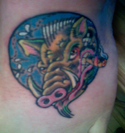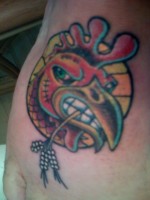While celebrating passing one million pages views on the blog, it seems worthwhile to take a look back at the single most popular post. It was Sailor’s Tattoos – Pigs, Chickens, Swallows, and Tattooed Backsides, from December 1, 2008, which has been viewed almost 27,000 times. That is less than 3% of all pageviews but is still around three times higher than its closest competitor.
Sailor’s Tattoos – Pigs, Chickens, Swallows, and Tattooed Backsides
 Tattoos have become very popular of late. Tattoo Facts & Statistics notes that “thirty-six percent of those ages 18 to 25, and 40 percent of those ages 26 to 40, have at least one tattoo, according to a fall 2006 survey by the Pew Research Center.” As popular as tattoos are with twenty and thirty somethings, sailors have been marking their bodies for most of history.
Tattoos have become very popular of late. Tattoo Facts & Statistics notes that “thirty-six percent of those ages 18 to 25, and 40 percent of those ages 26 to 40, have at least one tattoo, according to a fall 2006 survey by the Pew Research Center.” As popular as tattoos are with twenty and thirty somethings, sailors have been marking their bodies for most of history.
 Many years ago a retired ship’s captain told me that his youth deckhands often had “HOLD FAST” tattooed across the knuckles of their hands so they wouldn’t fall when they went aloft. They also often had a pig tattooed on one foot and chicken the other which was supposed to protect you from drowning. He told me that he never figured out which foot was supposed to be tattooed with the chicken and which with the pig. He would say, with a twinkle in his eye, that he never got the tattoos because he was afraid of getting them on the wrong feet.
Many years ago a retired ship’s captain told me that his youth deckhands often had “HOLD FAST” tattooed across the knuckles of their hands so they wouldn’t fall when they went aloft. They also often had a pig tattooed on one foot and chicken the other which was supposed to protect you from drowning. He told me that he never figured out which foot was supposed to be tattooed with the chicken and which with the pig. He would say, with a twinkle in his eye, that he never got the tattoos because he was afraid of getting them on the wrong feet.
 There are two versions of the story as to why a pig and chicken will prevent a sailor from drowning. The first is just that pigs and chickens do not like water, so they would like to be out of the water as soon as possible. A slightly more plausible explanation is that pigs and chickens were often carried on deck in wooden pens. In a shipwreck the pens would often wash ashore with the other debris from the ship. Pigs and chickens were at times th only survivors of ship wrecks. A more prosaic explanation was that having a pig and chicken tattoo would guarantee that a sailor eats well as he carries his hams and eggs with him at all times.
There are two versions of the story as to why a pig and chicken will prevent a sailor from drowning. The first is just that pigs and chickens do not like water, so they would like to be out of the water as soon as possible. A slightly more plausible explanation is that pigs and chickens were often carried on deck in wooden pens. In a shipwreck the pens would often wash ashore with the other debris from the ship. Pigs and chickens were at times th only survivors of ship wrecks. A more prosaic explanation was that having a pig and chicken tattoo would guarantee that a sailor eats well as he carries his hams and eggs with him at all times.
One variation was to have a tattoo of a pig on the left knee and a rooster (cock) on the right foot signified “Pig on the knee, safety at sea. A cock on the right, never lose a fight.”
Sailors also got bird tattoos to signify the completion of voyages. Sparrow, swallow and/or blue bird tattoos were used to signify 5,000 miles sailed. Compass roses, stars, ships, dragons, turtles, rope, daggers and cannon all have their own significance to the wearer of the tattoo. To read more click here or here.
Ironically, while tattooing has been practiced for thousands of years, the word “tattoo” entered the language relatively recently. Captain Cook first recorded his derivation of the Samoan word “tatau” in his log in 1769. Tattooing was obviously very popular among seaman of the day. Many of the Bounty mutineers of 1789 were identified by their tattoos. Fletcher Christian, the leader of the mutiny, was reported to have “a star tattooed on his left breast,” and to be “tattooed on his backside”.
So far I have resisted the urge to follow Christian’s example and have my backside tattooed but a star or two sounds interesting.

An interesting analysis and recap!
Happy Christmas!!